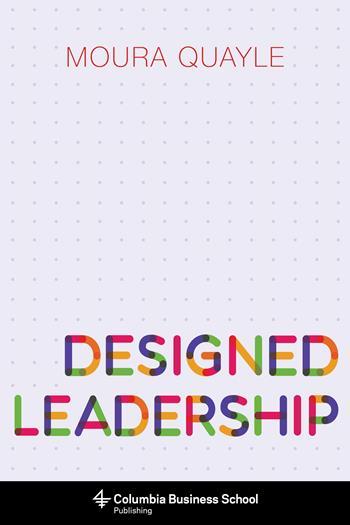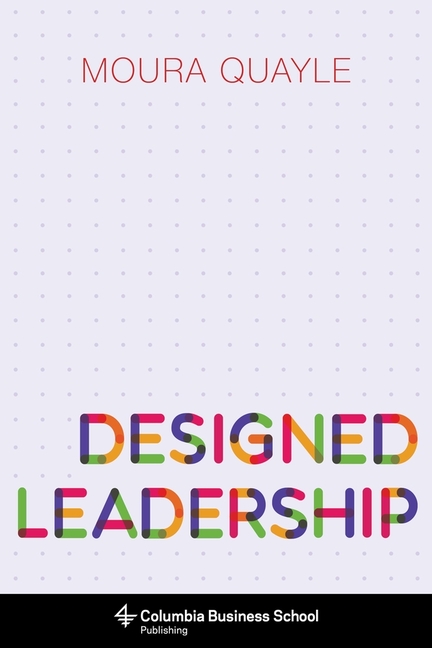Designed Leadership
July 14, 2017
Moura Quayle's new book give readers is a great history of design thinking, a glimpse of its future, and the tools we need to bring it about.

Designed Leadership by Moura Quayle, Columbia Business School Publishing, 272 pages, Hardcover, July 2017, ISBN 9780231173124
Leadership is about transformation. Commerce—along with the marketplace of ideas in academia and the public sector—is an ever-changing ecosystem that needs to be navigated, and navigation requires both critical and creative thinking. Too often, leadership lacks that, and is either ineffectual or in the way. That is why leadership, and how it is taught and practiced, is currently undergoing a transformation.
Moura Quayle, a professor of strategic design at the Sauder School of Business at the University of British Columbia, is at the forefront of that transformation. Her new book, Designed Leadership, is a great guide and resource for those looking to join her in the vanguard.
Frederick Taylor’s Principles of Scientific Management still holds sway in the business world. Even if you’ve never heard of it, it is the proverbial water we all swim in. Taylorism did wonders in the industrial era, professionalizing management and increasing the productivity and efficiency of the industrial worker and world. But the wicked problems we face today require more than that—they require creativity. Rather than a scientific approach (or perhaps in addition to it) we need a design approach to leadership.
Design thinking has picked up steam in the business and technology worlds in recent years, especially in the development of user interfaces and experience, but its origins go back much further:
Despite a disproportionate amount of design literature claiming that the origin of a human-centric approach to design lies with computer science and artificial intelligence, other design disciplines, like built-environment design, have always held the user as the most important player in the design process.
In fact, a book on architecture and urban planning, called Design Thinking, by Peter Rowe, was released in 1987. It is a book that Moura Quayle, with her background as a landscape architect and urban designer, knows well and references often in Designed Leadership. It is that experience, along with her work in urban policy and public service as a deputy minister, and her life as a professor and university dean, that adds such great breadth of knowledge and understanding to the book. It is a key differentiator of this book from others on design thinking.
Designed leadership begins with clearly defining your values, making them explicit, communicating them and using them intentionally in decision making. It requires leaders to “listen carefully and communicate consistently,” and to incorporate new language into the business lexicon:
Language is the medium we use to explore and learn, to grow and change—based on our values. So, connecting the languages of business and the language of design has the potential to create new language and new behavior—and, ideally, new approaches to problem solving.
It is vitally import to clarify your own values, and to work with colleagues to define the key values of the community or organization. Once defined, it is important to use values in decision-making and strategic thinking.
If that sounds vague or mushy, rest assured that this is one of the more immediately applicable books you’ll read this year. Quayle clearly defines the “Ten Principles of Designed Leadership,” gives you “Five Techniques for Learning Designed Leadership,” and provides countless other tools and processes you can implement right away, with an ultimate focus on the “Doing” stage of the “Ask, Try, Do” strategic design method:
Design is active. It is a verb. Design is not just about thinking, but about constantly trying and doing.
It is, as one of Quayle’s ten designed leadership principles states, “Never Finished but Always Complete.” In this way, also, designed leadership is active leadership.
The book is academic, but it’s not dry. It is more educational than entertaining, and doesn’t contain the endless, entertaining anecdotes employed in most modern business books. But it is heavily, attractively illustrated by the author, and she draws often from her own experience and a broader range of scholarship and literature than most—so when anecdotes are included, they are delightfully different than the usual business book fare. For instance, I’ve never known the history of the question mark, which Quayle has remedied. The book is also strengthened by the elegant simplicity of some of its solutions—often in response to incredibly complex problems, such as the fact that:
Humans often confuse facts (objective information) and interpretations (insights). There is a great deal of difference between the hard, cold certainties of what you see and hear—the facts of your observation—and your interpretation of what you see and hear—your insights. Comingling observations and insights result in a lack of clarity. Carefully separating them reveals our knowledge gaps, showing us where we need to seek more evidence.
One solution to that problem is to simply make a list, as “List-making is both a logistical tool and a creative activity.” Making lists is also a great strategy for determining what is essential to a solution, and what might simply be desirable—the “must have, and the should-haves or the nice-to-haves.”
The book teaches us how to think visually and spatially, explains how drawing and writing can be used to clarify complex issues. Quayle even teaches you how to design the physical space you work in, and it may be one of the more important evolutions you can make. She encourages setting up studio environments in the workplace, in which ongoing, active learning and sharing of ideas can occur, and using it as a type of pedagogy and process for ongoing innovation. She encourages business schools to integrate design practices, and design schools to integrate business knowledge, and is at the forefront of that effort with the Sauder d.studio at Sauder School of Business at the University of British Columbia (one of only 13 postsecondary business studios in the world that she is aware of).
At the end of that book, there is even an appendix on “The Evolution of Strategic Design in Business Thinking” that seems like a curious add-on at first considering all that she’s done throughout the book to educate us on that very topic, but ends up being one of the most erudite and succinct explorations of the history of business books that I’ve ever come across, going back to Taylor's Principles of Scientific Management—and before.
But the real strength of Designed Leadership isn’t its detailed history of design thinking, as great as that is. It is that it gives us glimpse of its future, and the tools we need to bring it about.


